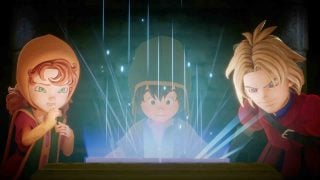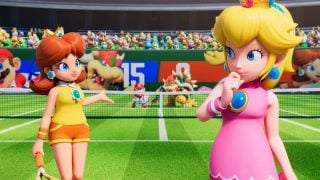Super Smash Bros. has always been a franchise that revels in the history of video games, no matter how obscure it gets, and one of the best ways it can celebrate this history is through stages.
“Setting the Stage” is a new series of articles that will pick apart and give some context to the stage design decisions made by Masahiro Sakurai and his team over the years. First up is perhaps the most bizarre arena in the franchise’s history: the auto-scrolling pastel party that is Pac-Land.
Pac-Land is based on the 1984 arcade title of the same name, and its reputation for strangeness is nothing new. Not only was Pac-Land the first Namco developed Pac-Man game to move away from the iconic maze gameplay, but it was also the first to give him arms and legs, something only seen before on the side of cabinets. Players controlled this newly-limbed Pac-Man through perilous environments in a rush to return the fairy that’s inexplicably in his hat to her home, the creatively named Fairyland.
Of course, the most noticeable aspect of the Smash Bros. stage is the rather, well, “unique” art style. Considering the buildings and obstacles look like something out of an eight year old’s MS Paint folder, it’s no surprise many players are dismissive of the level at first. However, much like the Duck Hunt and Balloon Fight stages, Pac-Land is made up entirely of assets from the original arcade game, which goes some way to explain their crudeness.
Both the arcade game and the stage begin in the city, where the main obstacles are water-spewing fire hydrants. The enemies from the arcade game unfortunately don’t make an appearance in the Super Smash Bros. stage, which is a shame considering they include ghosts doing everyday things like driving cars, riding pogo sticks, and dropping their offspring from windows onto Pac-Man’s head.
After leaving the city Pac-Man enters the woods, which were a technically impressive part of the original arcade game thanks some incredibly early use of parallax scrolling. This is the name given to the perspective effect where both foreground and background elements move independently, giving a sense of depth. Parallax scrolling was something home console owners didn’t really experience until the 16-bit era, meaning many of Pac-Land’s contemporary ports were graphically inferior (which explains why the stage uses arcade assets rather than those of the NES port.)
At the end of Pac-Man’s journey, he enters the door to Fairyland. This sequence is accurately recreated in the stage, with a larger fairy appearing, floating to the left, and conjuring up some red boots with wings. In the arcade game these boots help Pac-Man run back home with infinite jumps, whereas in Smash Bros. they just increase the jump height of whoever picks them up first. These boots also make an appearance in a few of Pac-Man’s palette swaps.
When Pac-Man finally makes it home he’s welcomed back by his family, although strangely in the Smash Bros. stage only Ms. Pac-Man is there, their baby (Pac-Baby?) is nowhere in sight. It’s after this little sequence that the game loops and a new trip begins. In the original game this meant an increase in difficulty with different level layouts and enemy placements, but in the Smash Bros. stage it only emulates the changing time of day (and considering it takes 3 minutes per cycle it’s very unlikely your average player will see night time.)
One last thing worth mentioning is the team’s commitment to minor details. In the original arcade game the player could get extra points at the end of each section by jumping repeatedly, with a little sign popping up to show them just how well they did. The Smash Bros. team went out of their way to emulate this tiny visual effect in a game that doesn’t even have scoring, yet again showing their commitment to authenticity in the game’s retro themed stages.
Hopefully this article has helped give some context to one of the more controversial stages in Super Smash Bros. history. When it comes down to it Pac-Land was one of the first-ever side-scrolling platformers (predating Super Mario Bros. by a year), and the team at Sora no doubt understood its historical significance when they chose the stage to represent the iconic yellow orb.
Really, if you want to hate something about the stage, hate how they completely omitted Pac-Land’s incredibly memorable theme from its My Music selection. It’s just oh so catchy.
Leave a Comment






